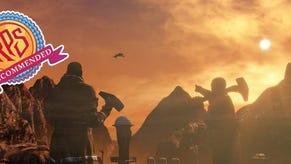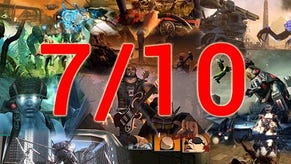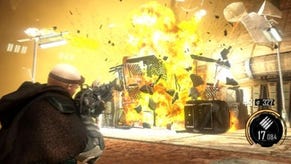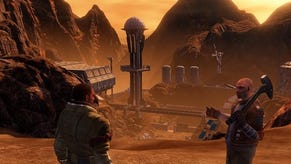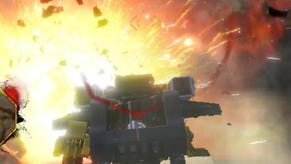Red Faction: Guerilla's destructible scenery makes it still worth playing today
Just to watch the world burn
Two hostages. One building. Five government guards with reinforcements waiting in the wings. In most games, I'd try to sneak in with a silenced rifle, methodically popping enemies in the head one-by-one. But in Red Faction: Guerrilla, I don't even have a gun in my inventory, let alone a silenced one. What I have instead are explosives. Lots of explosives.
I rig five charges at random points on the outside of the building, retreat to a safe distance, and squeeze the detonator. Glass shatters and debris flies off at all angles, a steel girder whizzing past my left ear as concrete and metal crumble down on top of the EDF soldiers, crushing them alive. But, predictably, the hostages are caught in the chaos. One is buried in the rubble, the other limping out with her health in the red.
The game tries to make me feel bad, alerting me that 'morale' in the local area has fallen to account for the dead guerrilla fighter. But I really don't care. Because blowing up buildings is fun – and Red Faction: Guerrilla makes it more fun than any other game out there.
Its destruction physics remain the best in gaming, and virtually every building on the surface of the Martian setting can be torn apart in responsive ways. If you fire a rocket at a particular corner of a tall tower, that area will crumble and the building will topple over its weak point, destroying other structures in its path.
Blowing stuff up in this game never, ever gets old, and I’ve spent countless hours driving around ignoring missions in favour of trying to create the loudest, most spectacular chain reactions possible. It’s damned addictive.
If it were just mindless destruction, I’d be fine with it. But the game gives the player freedom to use its physics in interesting ways. There are guns, but I used them sparingly, instead opting for remote charges and rocket launchers as my primary tools. Why shoot a soldier standing on a bridge when you can blow up the gas pipes below him and send him tumbling to his death?
There’s scope for more tactical uses, too. You can surprise enemies by punching through walls at the back of compounds, essentially creating new access routes for mission areas. You can destroy bridges as enemy tanks drive across, stopping their pursuit short. Tasked with taking out enemies, you can place charges strategically to blow out the front of the building they're hiding within, exposing them to your gunfire.
Combat is tough – too tough in my opinion, and the sheer number of enemies often means you’ll have to actually resort to firing your gun and ducking behind cover. It’s worth dialling it down to easy, and even then you’re sometimes overwhelmed. Luckily, blowing up buildings or particular parts of enemy compounds is a handy way of creating escape routes when it all gets too much.
If you tire of your arsenal of explosives, there are other ways to bring down a building. Vehicles become deadly battering rams that can weaken structures and take out propaganda posters for the EDF in a pinch. And, occasionally, you’ll get access to Walkers: giant mechs that can rip through buildings in seconds. They show the environments at their destructible best.
Then there’s the star of the show: your trusty sledgehammer. It’s impossibly strong, never falling apart as you swing away at steel and brick, hacking down entire buildings like a lumberjack felling a great oak tree. Whacking walls is a visceral experience and the audio cues do a good job of creating a sense of impact. But the sledgehammer is perhaps best when used against enemies, as seen below.
Released in 2009, the game has aged badly in some ways. Most missions are simply ‘go over there and blow that building up’, which is fine, but there are too many filler tasks that involve tracking couriers or delivering vehicles to safe houses.
But the physics still hold up. In fact, it stands head and shoulders above more recent games that have dipped their toe into destructible environments, such as the Battlefield series.
It all begs the question: with a mechanic this fun, why haven't more games implemented it? I can’t help but be excited at the prospect of seeing whole skyscrapers tumble in series like Saints Row or Grand Theft Auto.
Well, there's probably a good reason why those games didn’t try. RF: G has to compensate in a lot of ways to make the mechanic work. Its environments are sparse: buildings are separated in compounds so that the destruction can be contained. If one building collapses, there are only so many other buildings it can fall onto before the chain reaction sputters out. The graphics, too, take a hit, with the development team focusing on building architecture over realistic textures.
It also required a huge investment of time and money from the development team. Developers Volition spent six months making the engine, called GeoMod 2.0, to allow it to support the destruction. The structures are made up of what the team called “shards”, essentially small fragments that break off along specified joints when the building is destroyed. Those individually-crafted pieces have to be small enough so that they can respond differently to forces from different directions, meaning that to the player, the destruction looks as realistic as possible.
What that all means is that, even now, producing similar destruction mechanics is no easier, and would still require developers to compromise on graphics to the extent that mainstream audiences would turn away. Riot Games product manager Jim Boone, previously senior producer at Volition, worked on Red Faction: Guerilla, its follow up Red Faction: Armageddon, and Saint’s Row IV, and an interview he did with VG247 in 2013 is telling.
“The technology behind that is so amazing and also so restrictive at the same time, that the problem is that the density of buildings you can do with that engine literally couldn’t come close to being done to represent the kind of cities we do in Saints Row,” he said.
“My suspicion is that if you looked at another game coming out that didn’t have that technology, that their buildings would look so superior to ours, the gamers would still look at it and say, ‘Wow, what’s wrong with Saints Row, why does it look so horrible? The city just looks awful compared to what I’m seeing in these other games because of the destruction.’ With the kind of competition that’s out there I think, I suspect it would almost be impossible to do it and still remain competitive visually.”
I reckon Boone is wrong and that gamers, especially on PC, would tolerate muddy textures if they could get their hands on dense, destructible environments. But that’s not the way developers see it and, sadly, for that reason we’re unlikely to see another game that does destruction as well as Red Faction: Guerrila, at least for the foreseeable future. Which makes it, in some ways, a piece of gaming history - and an important reminder of how fun it is to blow shit up.



